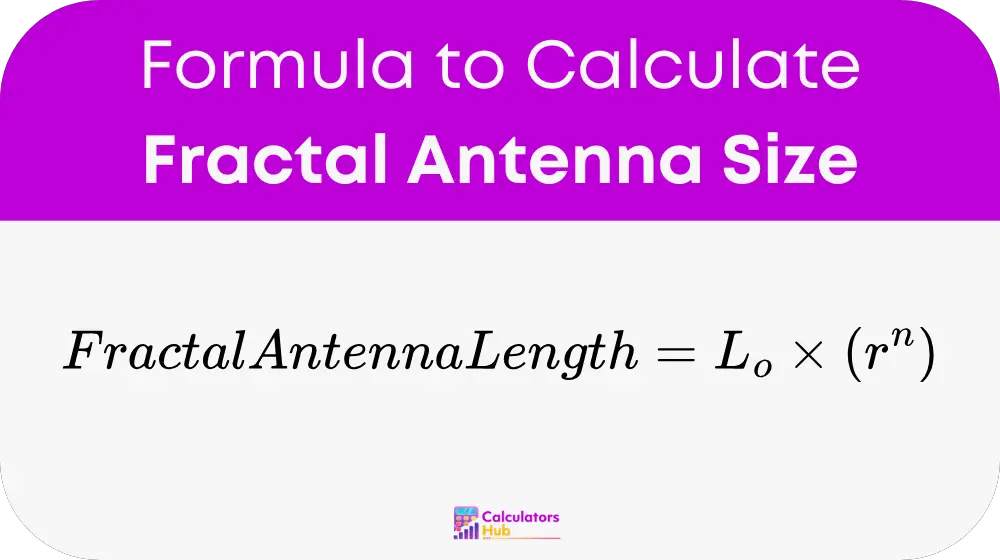A Fractal Antenna Size Calculator is a design tool that estimates the effective electrical length of an antenna based on a repeating geometric pattern, known as a fractal. The core benefit of a fractal design is its ability to fit a very long electrical length into a small physical space, which is crucial for miniaturizing antennas. This calculator takes a base length, the specific type of fractal pattern, and the number of times the pattern is repeated (iterations) to determine the final conductive length. This final length dictates the resonant frequencies of the antenna. Consequently, radio frequency (RF) engineers and hobbyists use this tool to design compact, multi-band antennas for devices like cell phones and GPS units where space is limited.
formula of Fractal Antenna Size Calculator
The total electrical length of a fractal antenna is calculated by scaling an initial length by a growth factor for a certain number of iterations.

Where:
L₀ = The initial straight-line length, which is the base segment of the antenna.
r = The growth factor, which depends on the specific fractal type.
n = The number of iterations or levels of fractal detail applied.
For a Koch Curve (a common fractal antenna type):
The Koch curve replaces each straight line segment with four smaller segments, each being one-third of the original length. This results in a growth factor of 4/3.
Length = L₀ × (4/3)^n
Where:
L₀ = The initial straight segment.
Each iteration increases the complexity and the total electrical length of the wire.
For Fractal Area or Size Estimation:
While length is the primary concern for resonance, the physical footprint can also be estimated.
Fractal Area ≈ A₀ × (Scale Factor)^n
The area or footprint calculation depends heavily on the specific design pattern being used, such as a Sierpinski triangle or a Minkowski loop.
Growth of a Koch Fractal Antenna's Electrical Length
This table demonstrates how the total electrical length of an antenna based on a Koch fractal increases with each iteration. The physical footprint of the antenna remains constrained by the initial length (L₀), while the electrical length grows significantly.
| Number of Iterations (n) | Length Calculation (using L₀ as base) | Total Electrical Length |
| 0 (a straight wire) | L₀ × (4/3)⁰ | 1.00 × L₀ |
| 1 | L₀ × (4/3)¹ | 1.33 × L₀ |
| 2 | L₀ × (4/3)² | 1.78 × L₀ |
| 3 | L₀ × (4/3)³ | 2.37 × L₀ |
| 4 | L₀ × (4/3)⁴ | 3.16 × L₀ |
Example of Fractal Antenna Size Calculator
An engineer wants to design a compact fractal antenna to operate at 433 MHz. A standard quarter-wave antenna at this frequency would be too long for the device.
Step 1: Determine the initial length (L₀).
A standard quarter-wavelength antenna at 433 MHz is approximately 0.173 meters or 17.3 cm. Let's set L₀ = 17.3 cm. This will be the physical footprint of the antenna.
Step 2: Choose the fractal design and number of iterations.
The engineer chooses a Koch curve design and decides to apply 2 iterations (n = 2) to increase the electrical length.
Step 3: Calculate the new total electrical length.
Length = 17.3 cm × (4/3)²
Length = 17.3 cm × (1.777) ≈ 30.75 cm
The new electrical length of the antenna is approximately 30.75 cm, which will resonate at a much lower frequency than 433 MHz. By using a fractal design, the engineer has created an electrically longer antenna while keeping its physical size contained to the original 17.3 cm footprint.
Most Common FAQs
Fractal antennas offer two primary advantages. First is miniaturization: they can achieve a long electrical length in a small physical area, making them ideal for low-frequency applications in compact devices. Second is multi-band performance: the self-similar repeating patterns within the fractal can cause the antenna to be resonant at multiple, harmonically related frequencies.
An iteration is one step in the process of generating a fractal shape. You start with a simple base shape (iteration 0). In the first iteration, you apply a rule to modify that shape. In the second iteration, you apply the same rule again to all the new parts of the shape. Each iteration adds complexity and detail, increasing the antenna's total electrical length.
Not necessarily, and this is the key benefit of fractal antennas. The physical size, or footprint, can remain small and defined by the initial base length (L₀). However, the total length of the conductive wire is folded into that small space, creating a much longer electrical path.